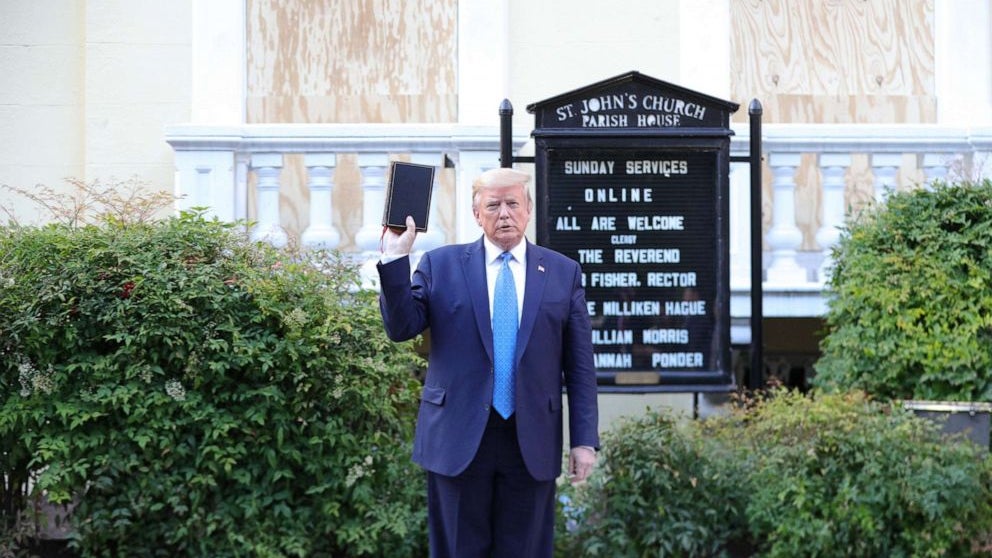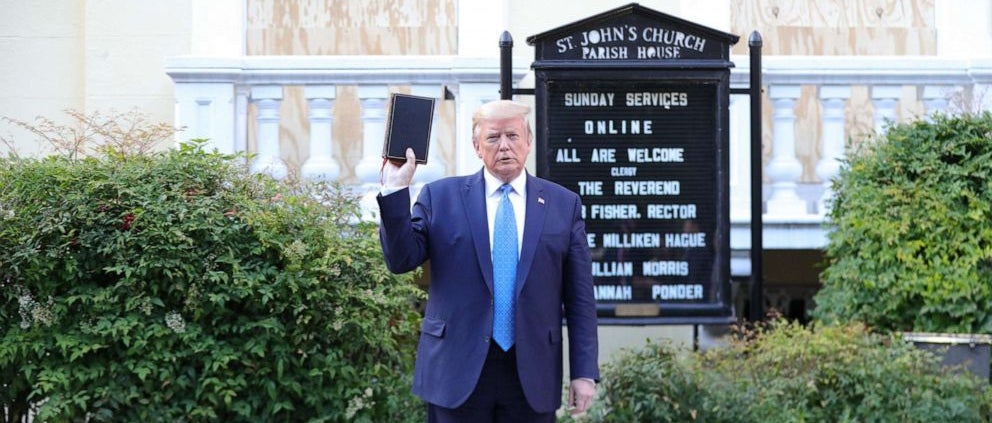Police cleared Lafayette Square in June 2020 for fencing installation by a contractor, not for former President Donald Trump's photo-op in front of a church, according to an Interior Department inspector general’s report.
According to an Interior Department inspector general’s report, the U.S. Park Police did not clear protesters from Lafayette Park outside of the White House so that former President Donald Trump could take a photo-op at St. John’s Church.
As reported by ABC News, Trump walked to St. John's Church a day after it had been vandalized over protests regarding police brutality and racial reform. As Trump made his way to the church, law enforcement cleared what had been for the most part peaceful demonstrations in the park. As those scenes unfurled, Trump posed for photos, holding up a Bible.
However, the report did indicate that the U.S. Park Police learned of Trump’s interest in surveying the site hours after they began to clear the area to set up new fencing, according to NBC News.
The report stated that the Park Police made the decision "to allow a contractor to safely install antiscale fencing in response to destruction of Federal property and injury to officers."
The Interior Department's inspector general did not decide if the police acted improperly against demonstrators last year and did not zero-in on individual incidents of police utilization of force as reported by ABC News. It did, however, discover that poor correspondence between agencies and unsuccessful dispersal alerts “may have contributed to confusion during the operation and the use of tactics that appeared inconsistent."
The report "does not clear law enforcement on use of force and acknowledges problems with its response... This report does not address allegations of individual use-of-force incidents, as those are the subject of separate inquiries as well as ongoing lawsuits."
Within the report, it highlighted several main topics of concern pertaining to the U.S. Secret Service’s deployment prior to the USPP beginning its dispersal warning and "the USPP's failure to provide dispersal warnings that were loud enough for everyone to hear and that told protesters where to exit before the clearing operation began."
In particular, the report found that Bureau of Prisons officials on the scene utilized pepper spray against protestors and that Metropolitan Police officials utilized tear gas, in spite of requests from Park Police not to do as such.
Also, the Secret Service deployed against protestors before the primary dispersal orders were given — and admonitions requesting that demonstrators clear-out were not heard by protestors before police began forcefully clearing the park according to ABC News.
The office also decided that the Park Police officials acted inside their power to start clearing Lafayette Square before the city's 7 p.m. curfew, a move that was publicly reprimanded and criticized at the time as having added to the disarray at the scene.
As reported by NBC News, in response to the Interior Department inspector general’s report, Trump reacted victorious and relieved, and thanked the inspector for "Completely and Totally exonerating me in the clearing of Lafayette Park!"
Park Police authorities said the arrangement to clear the area was set up before a 2 p.m. meeting that included then-Attorney General William Barr. According to the report, the Park Police operations commander said "the Attorney General did not mention a potential presidential visit to the park."
The timetable of occurrences on that day showcase two distinct dichotomies: on one side, the Park Police's arrangement to clear dissenters to construct a fence, and on the other, Trump's desire to address what he described in a Rose Garden discourse as brutal protests and then afterward walked to the church.
According to the report, "The Secret Service lieutenant later apologized for the early entry onto H Street during the operation but did not explain why it occurred," adding, "Some speculated it occurred because of miscommunication between a Secret Service supervisor and his officers near the gate area. Others guessed it could have occurred because the USPP and the Secret Service did not have a shared radio channel and had no way of intercepting and resolving conflicting radio communications."
Related Stories







